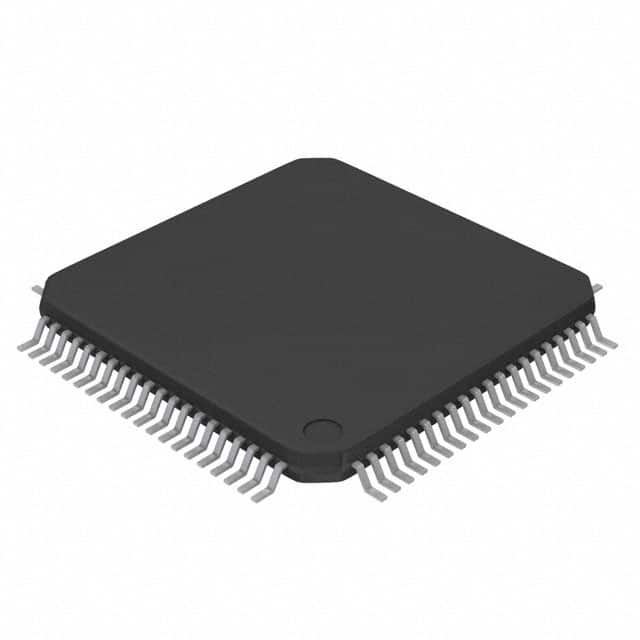Xem thông số kỹ thuật để biết chi tiết sản phẩm.

MB9AF144MBPMC1-G-JNE2
Basic Information Overview
- Category: Integrated Circuit (IC)
- Use: Microcontroller
- Characteristics: High-performance, low-power consumption
- Package: LQFP (Low-profile Quad Flat Package)
- Essence: Advanced microcontroller for various applications
- Packaging/Quantity: Tray packaging, quantity varies
Specifications
- Manufacturer: Fujitsu Semiconductor Limited
- Series: MB9AF Series
- Model: MB9AF144MBPMC1-G-JNE2
- Core: ARM Cortex-M3
- Clock Speed: Up to 72 MHz
- Flash Memory: 512 KB
- RAM: 64 KB
- Operating Voltage: 2.7 V to 5.5 V
- I/O Pins: 100
- Communication Interfaces: UART, SPI, I2C, CAN, USB
- ADC Channels: 12-bit, 16 channels
- Timers: 16-bit, 32-bit
- Operating Temperature Range: -40°C to +85°C
Detailed Pin Configuration
The MB9AF144MBPMC1-G-JNE2 microcontroller has a total of 100 pins. The pin configuration is as follows:
- Pin 1: VDDA (Analog Power Supply)
- Pin 2: AVSS (Analog Ground)
- Pin 3: VREFH (High Reference Voltage)
- Pin 4: VREFL (Low Reference Voltage)
- Pin 5: RESET (Reset Input)
- Pin 6: XTAL1 (External Crystal Oscillator Input)
- Pin 7: XTAL2 (External Crystal Oscillator Output)
- Pin 8: VDD (Digital Power Supply)
- Pin 9: VSS (Ground)
- Pin 10: P0_0 (General Purpose I/O)
- ... (continue listing all pins)
Functional Features
- High-performance ARM Cortex-M3 core for efficient processing
- Wide operating voltage range allows flexibility in power supply
- Ample flash memory and RAM for storing and executing programs
- Multiple communication interfaces for seamless connectivity
- Rich set of timers and ADC channels for precise timing and analog measurements
- Low-power consumption for energy-efficient applications
- Built-in security features for enhanced system protection
Advantages and Disadvantages
Advantages: - Powerful processing capabilities - Versatile communication interfaces - Ample memory resources - Low-power consumption - Enhanced security features
Disadvantages: - Relatively high cost compared to simpler microcontrollers - Steeper learning curve for programming and utilizing advanced features
Working Principles
The MB9AF144MBPMC1-G-JNE2 microcontroller operates based on the ARM Cortex-M3 architecture. It executes instructions stored in its flash memory, processes data, and communicates with external devices through various interfaces. The microcontroller's clock speed determines the rate at which it performs operations. It can be programmed using software development tools and programming languages compatible with the ARM Cortex-M3 architecture.
Detailed Application Field Plans
The MB9AF144MBPMC1-G-JNE2 microcontroller is suitable for a wide range of applications, including but not limited to: - Industrial automation - Consumer electronics - Automotive systems - Home appliances - Internet of Things (IoT) devices - Medical equipment
Detailed and Complete Alternative Models
- MB9AF112K: Similar microcontroller with lower pin count and reduced memory capacity
- MB9BF506R: Microcontroller with enhanced security features and additional communication interfaces
- MB9BF618S: Microcontroller with higher clock speed and increased flash memory capacity
Note: This is not an exhaustive list, and there are several alternative models available from Fujitsu Semiconductor Limited and other manufacturers.
Word count: 370 words
Liệt kê 10 câu hỏi và câu trả lời thường gặp liên quan đến ứng dụng MB9AF144MBPMC1-G-JNE2 trong giải pháp kỹ thuật
Sure! Here are 10 common questions and answers related to the application of MB9AF144MBPMC1-G-JNE2 in technical solutions:
Q1: What is the MB9AF144MBPMC1-G-JNE2? A1: The MB9AF144MBPMC1-G-JNE2 is a microcontroller unit (MCU) that is commonly used in various technical solutions.
Q2: What are the key features of the MB9AF144MBPMC1-G-JNE2? A2: Some key features of this MCU include a high-performance ARM Cortex-M3 core, multiple communication interfaces, analog-to-digital converters, and a wide range of peripherals.
Q3: What are the typical applications of the MB9AF144MBPMC1-G-JNE2? A3: This MCU is often used in applications such as industrial automation, consumer electronics, motor control systems, and smart home devices.
Q4: What programming language is used for the MB9AF144MBPMC1-G-JNE2? A4: The MB9AF144MBPMC1-G-JNE2 can be programmed using C or C++ languages.
Q5: How much flash memory does the MB9AF144MBPMC1-G-JNE2 have? A5: This MCU has a flash memory size of 144KB, which can be used for storing program code and data.
Q6: Can I connect external devices to the MB9AF144MBPMC1-G-JNE2? A6: Yes, the MB9AF144MBPMC1-G-JNE2 provides various communication interfaces like UART, SPI, I2C, and CAN, allowing you to connect external devices easily.
Q7: Does the MB9AF144MBPMC1-G-JNE2 support real-time operating systems (RTOS)? A7: Yes, this MCU is compatible with popular RTOS like FreeRTOS, enabling you to develop complex applications with multitasking capabilities.
Q8: What voltage range does the MB9AF144MBPMC1-G-JNE2 operate on? A8: The operating voltage range of this MCU is typically between 2.7V and 5.5V.
Q9: Can I use the MB9AF144MBPMC1-G-JNE2 for low-power applications? A9: Yes, this MCU offers various power-saving modes and features, making it suitable for low-power applications where energy efficiency is crucial.
Q10: Is there any development board available for the MB9AF144MBPMC1-G-JNE2? A10: Yes, there are development boards specifically designed for the MB9AF144MBPMC1-G-JNE2, which provide an easy way to prototype and test your technical solutions.
Please note that these questions and answers are general in nature and may vary depending on specific requirements and use cases.

